-

人教A版高中数学必修一幂函数教学设计(2)
幂函数是在继一次函数、反比例函数、二次函数之后,又学习了单调性、最值、奇偶性的基础上,借助实例,总结出幂函数的概念,再借助图像研究幂函数的性质.课程目标1、理解幂函数的概念,会画幂函数y=x,y=x2,y=x3,y=x-1,y=x 的图象;2、结合这几个幂函数的图象,理解幂函数图象的变化情况和性质;3、通过观察、总结幂函数的性质,培养学生概括抽象和识图能力.数学学科素养1.数学抽象:用数学语言表示函数幂函数;2.逻辑推理:常见幂函数的性质;3.数学运算:利用幂函数的概念求参数;4.数据分析:比较幂函数大小;5.数学建模:在具体问题情境中,运用数形结合思想,利用幂函数性质、图像特点解决实际问题。重点:常见幂函数的概念、图象和性质;难点:幂函数的单调性及比较两个幂值的大小.

人教A版高中数学必修一基本不等式教学设计(2)
《基本不等式》在人教A版高中数学第一册第二章第2节,本节课的内容是基本不等式的形式以及推导和证明过程。本章一直在研究不等式的相关问题,对于本节课的知识点有了很好的铺垫作用。同时本节课的内容也是之后基本不等式应用的必要基础。课程目标1.掌握基本不等式的形式以及推导过程,会用基本不等式解决简单问题。2.经历基本不等式的推导与证明过程,提升逻辑推理能力。3.在猜想论证的过程中,体会数学的严谨性。数学学科素养1.数学抽象:基本不等式的形式以及推导过程;2.逻辑推理:基本不等式的证明;3.数学运算:利用基本不等式求最值;4.数据分析:利用基本不等式解决实际问题;5.数学建模:利用函数的思想和基本不等式解决实际问题,提升学生的逻辑推理能力。重点:基本不等式的形成以及推导过程和利用基本不等式求最值;难点:基本不等式的推导以及证明过程.

人教A版高中数学必修一任意角教学设计(1)
本节课选自《普通高中课程标准数学教科书-必修一》(人 教A版)第五章《三角函数》,本节课是第1课时,本节主要介绍推广角的概念,引入正角、负角、零角的定义,象限角的概念以及终边相同的角的表示法。树立运动变化的观点,并由此进一步理解推广后的角的概念。教学方法可以选用讨论法,通过实际问题,如时针与分针、体操等等都能形成角的流念,给学生以直观的印象,形成正角、负角、零角的概念,明确规定角的概念,通过具体问题让学生从不同角度理解终边相同的角,从特殊到一般归纳出终边相同的角的表示方法。A.了解任意角的概念;B.掌握正角、负角、零角及象限角的定义,理解任意角的概念;C.掌握终边相同的角的表示方法;D.会判断角所在的象限。 1.数学抽象:角的概念;2.逻辑推理:象限角的表示;3.数学运算:判断角所在象限;4.直观想象:从特殊到一般的数学思想方法;
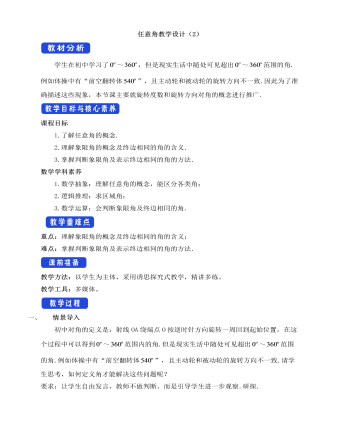
人教A版高中数学必修一任意角教学设计(2)
学生在初中学习了 ~ ,但是现实生活中随处可见超出 ~ 范围的角.例如体操中有“前空翻转体 ”,且主动轮和被动轮的旋转方向不一致.因此为了准确描述这些现象,本节课主要就旋转度数和旋转方向对角的概念进行推广.课程目标1.了解任意角的概念.2.理解象限角的概念及终边相同的角的含义.3.掌握判断象限角及表示终边相同的角的方法.数学学科素养1.数学抽象:理解任意角的概念,能区分各类角;2.逻辑推理:求区域角;3.数学运算:会判断象限角及终边相同的角.重点:理解象限角的概念及终边相同的角的含义;难点:掌握判断象限角及表示终边相同的角的方法.教学方法:以学生为主体,采用诱思探究式教学,精讲多练。教学工具:多媒体。一、 情景导入初中对角的定义是:射线OA绕端点O按逆时针方向旋转一周回到起始位置,在这个过程中可以得到 ~ 范围内的角.但是现实生活中随处可见超出 ~ 范围的角.例如体操中有“前空翻转体 ”,且主动轮和被动轮的旋转方向不一致.

人教A版高中数学必修二简单随机抽样教学设计
知识探究(一):普查与抽查像人口普查这样,对每一个调查调查对象都进行调查的方法,称为全面调查(又称普查)。 在一个调查中,我们把调查对象的全体称为总体,组成总体的每一个调查对象称为个体。为了强调调查目的,也可以把调查对象的某些指标的全体作为总体,每一个调查对象的相应指标作为个体。问题二:除了普查,还有其他的调查方法吗?由于人口普查需要花费巨大的财力、物力,因而不宜经常进行。为了及时掌握全国人口变动状况,我国每年还会进行一次人口变动情况的调查,根据抽取的居民情况来推断总体的人口变动情况。像这样,根据一定目的,从总体中抽取一部分个体进行调查,并以此为依据对总体的情况作出估计和判断的方法,称为抽样调查(或称抽查)。我们把从总体中抽取的那部分个体称为样本,样本中包含的个体数称为样本量。

人教A版高中数学必修一诱导公式教学设计(2)
本节主要内容是三角函数的诱导公式中的公式二至公式六,其推导过程中涉及到对称变换,充分体现对称变换思想在数学中的应用,在练习中加以应用,让学生进一步体会 的任意性;综合六组诱导公式总结出记忆诱导公式的口诀:“奇变偶不变,符号看象限”,了解从特殊到一般的数学思想的探究过程,培养学生用联系、变化的辩证唯物主义观点去分析问题的能力。诱导公式在三角函数化简、求值中具有非常重要的工具作用,要求学生能熟练的掌握和应用。课程目标1.借助单位圆,推导出正弦、余弦第二、三、四、五、六组的诱导公式,能正确运用诱导公式将任意角的三角函数化为锐角的三角函数,并解决有关三角函数求值、化简和恒等式证明问题2.通过公式的应用,了解未知到已知、复杂到简单的转化过程,培养学生的化归思想,以及信息加工能力、运算推理能力、分析问题和解决问题的能力。
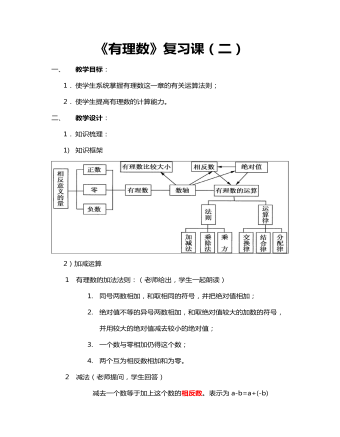
有理数复习教案教学设计
3)乘除运算①有理数的乘法法则:(老师给出,学生一起朗读)1. 两数相乘,同号得正,异号得负,并把绝对值相乘;2. 任何数与零相乘都得零;3. 几个不等于零的数相乘,积的符号由负因数的个数决定,当负因数有奇数个数,积为负;当负因数的个数为偶数个时,积为正;4. 几个有理数相乘,若其中有一个为零,积就为零。②有理数的除法法则:(老师提问,学生回答)1. 两个有理数相除,同号得正,异号得负,并把绝对值相除;2. 除以一个数等于乘以这个数的倒数。③关系(老师给出)除法转化为乘法进行运算。
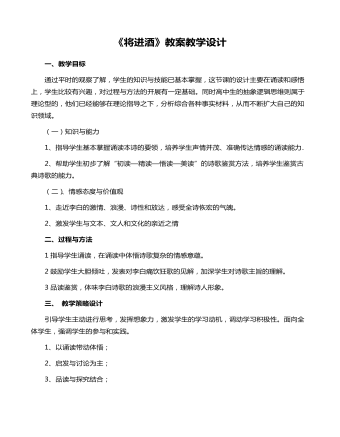
《将进酒》教案教学设计
教师活动 学生活动设计意图 情境导入:教师配乐叙述诗歌创作背景投入倾听 尽可能调动学生情绪诵读入境:“读李诗者于雄快之中得其深远宕逸之神,才是谪仙人面目”(投影展示)教师范读,酝酿情感(播放配乐)1、学生自读感知诗韵 2、学生齐读进入诗境 调动学生积极性,诵读时用自己的情绪感染学生精读涵咏:教师就诗歌内容进行提问,李白怎样喝酒,劝朋友喝酒的方式、原因,他有那些愁并说明理由,并按照自己的理解诵读。教师必要时给出相应的提示。投影展示:人生苦短 怀才不遇 交流研讨诵读 引导学生从诗句入手,疏通诗意,把握情感
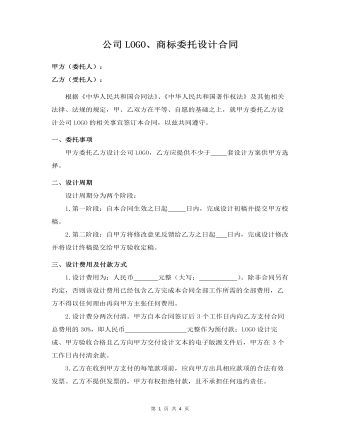
公司LOGO、商标委托设计合同
根据《中华人民共和国合同法》、《中华人民共和国著作权法》及其他相关法律、法规的规定,甲、乙双方在平等、自愿的基础之上,就甲方委托乙方设计公司LOGO的相关事宜签订本合同,以兹共同遵守。一、委托事项甲方委托乙方设计公司LOGO,乙方应提供不少于 套设计方案供甲方选择。二、设计周期设计周期分为两个阶段:1.第一阶段:自本合同生效之日起 日内,完成设计初稿并提交甲方校稿。2.第二阶段:自甲方将修改意见反馈给乙方之日起 日内,完成设计修改并将设计终稿提交给甲方验收定稿。三、设计费用及付款方式1.设计费用为:人民币 元整(大写: )。除非合同另有约定,否则该设计费用已经包含乙方完成本合同全部工作所需的全部费用,乙方不得以任何理由再向甲方主张任何费用。2.设计费分两次付清。甲方自本合同签订后3个工作日内向乙方支付合同总费用的30%,即人民币?????????元整作为预付款;LOGO设计完成、甲方验收合格且乙方向甲方交付设计文本的电子版源文件后,甲方在3个工作日内付清余款。3.乙方在收到甲方支付的每笔款项前,应向甲方出具相应款项的合法有效发票。乙方不提供发票的,甲方有权拒绝付款,且不承担任何违约责任。
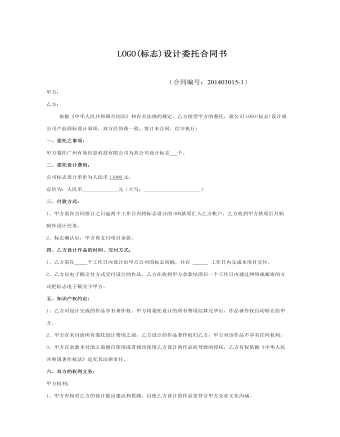
LOGO(标志)设计委托合同书
依据《中华人民共和国合同法》和有关法规的规定,乙方接受甲方的委托,就公司LOGO(标志)设计或公司产品商标设计事项,双方经协商一致,签订本合同,信守执行:一、委托之事项:甲方委托广州有易信息科技有限公司为其公司设计标志 个。二、委托设计费用:公司标志设计单价为人民币11000元,总价为:人民币______________元(大写:______________________)三、付款方式:1、甲方需在合同签订之日起两个工作日内将标志设计的30%款项汇入乙方帐户,乙方收到甲方款项后开始制作设计任务。2、标志确认后,甲方再支付项目余款。四、乙方设计作品的时间、交付方式:1、乙方需在 个工作日内设计出甲方公司的标志初稿。并在 工作日内完成本项目交付。2、乙方以电子稿交付方式交付设计的作品,乙方在收到甲方余款结清后一个工作日内通过网络或邮寄的方式把标志电子稿交予甲方。五、知识产权约定:1、乙方对设计完成的作品享有著作权。甲方将委托设计的所有费用结算完毕后,作品著作权自动转让给甲方。2、甲方在未付清所有委托设计费用之前,乙方设计的作品著作权归乙方,甲方对该作品不享有任何权利。3、甲方在余款未付清之前擅自使用或者修改使用乙方设计的作品而导致的侵权,乙方有权依据《中华人民共和国著作权法》追究其法律责任。
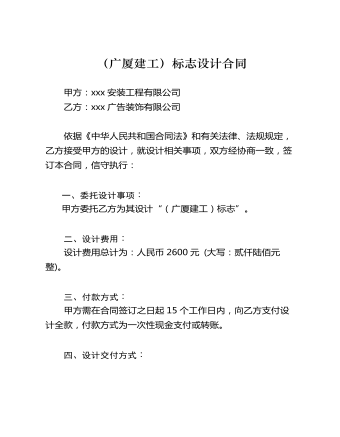
(广厦建工)标志设计合同
甲方:xxx安装工程有限公司 乙方:xxx广告装饰有限公司依据《中华人民共和国合同法》和有关法律、法规规定,乙方接受甲方的设计,就设计相关事项,双方经协商一致,签订本合同,信守执行: 一、委托设计事项:甲方委托乙方为其设计“(广厦建工)标志”。二、设计费用:设计费用总计为:人民币2600元 (大写:贰仟陆佰元整)。三、付款方式:甲方需在合同签订之日起15个工作日内,向乙方支付设计全款,付款方式为一次性现金支付或转账。四、设计交付方式:1、乙方自合同签订之日起15日内,以电子稿形式向甲方交付设计方案。
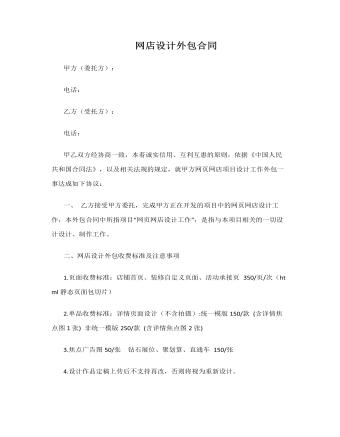
网店设计外包合同
甲乙双方经协商一致,本着诚实信用、互利互惠的原则,依据《中国人民共和国合同法》,以及相关法规的规定,就甲方网页网店项目设计工作外包一事达成如下协议:一、 乙方接受甲方委托,完成甲方正在开发的项目中的网页网店设计工作,本外包合同中所指项目“网页网店设计工作”,是指与本项目相关的一切设计设计、制作工作。二、网店设计外包收费标准及注意事项1.页面收费标准:店铺首页、装修自定义页面、活动承接页 350/页/次(html静态页面包切片)2.单品收费标准:详情页面设计(不含拍摄):统一模版150/款 (含详情焦点图1张) 非统一模版250/款 (含详情焦点图2张)3.焦点广告图50/张 钻石展位、聚划算、直通车 150/张4.设计作品定稿上传后不支持再改,否则将视为重新设计。三、双方权利及义务1、乙方托管服务方式:远程为客户操作(不提供上门服务)
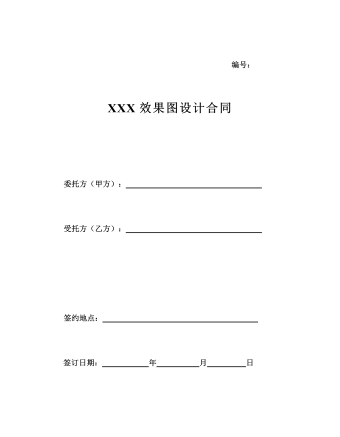
XXX效果图设计合同
根据《中华人民共和国广告法》,《中华人民共和国合同法》及国家有关法律、法规的规定,甲、乙双方在平等、自愿、等价有偿、公平、诚实信用的基础上,经友好协商,就甲方委托乙方设计、制作 效果图事宜,达成一致意见,特签订本合同,以资信守。第一条 委托事项(具体见 )第二条 合同总价款及付款方式1、本合同设计费单价为人民币 元(大写: ),输出打样等其他费用为人民币 元(大写: ),暂定总价款为人民币 元(大写: ),按实验收结算。前述费用已包括税费、设计费、输出及打印等一切费用,若甲方有特殊要求,甲乙双方应另行协商。2、本合同签订后 个工作日内,甲方应向乙方支付合同总价款的 %,即人民币(大写): 作为预付款。3、乙方交付设计成果经甲方验收达到合同约定的设计要求和验收标准后 个工作日内,甲方向乙方支付合同结算余款。4、以上付款,甲方将以转帐支票或电汇的方式支付,若甲方提出按六个月的承兑汇票支付的,则按开票银行同期贴现利息补息。付款时,乙方须向甲方开具中华人民共和国大陆地区合法有效的等额发票,否则甲方可顺延付款。
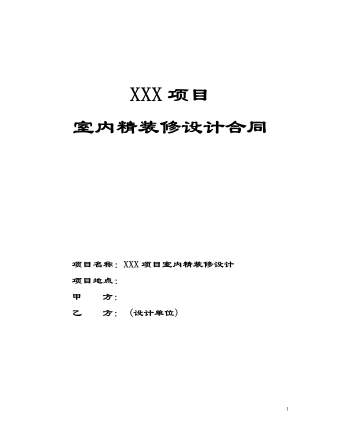
室内精装修设计合同
第一条 定义除上下文另有要求外,以下各词和用语,应具有如下的涵义:1.1 “适用法律”指在中华人民共和国和长沙市已颁布并生效的具有法律效力的法律和其它文件。1.2“服务”指本协议设计任务书所述的,按照协议由乙方完成本项目而进行的工作。1.3 “货币”指人民币元,本协议另有约定的除外。第二条 解释合同文件的组成及优先顺序:(1) 本合同协议(由标准及特殊条件、担保条款(如有)三部分组成)及附件(2) 经甲方认可的乙方承诺(3) 招标文件及其附件(如有)(4) 投标书及其附件(如有)(5) 中标通知书(6) 标准、规范及有关技术文件第三条 项目概况及服务内容、标准3.1 项目概况及服务内容、标准等见第二部分规定。3.2甲方为建造本项目所需要的设计服务的任何内容,并不会因为本协议的局限而被视为遗漏,乙方保证在规定的期限内按质按量完成规划部门、政府相关部门和甲方所需的全部设计文件。第四条 设计服务费4.1 本协议设计服务价格总额及费用明细见第二部分的规定。4.2 本协议第4.1条规定的设计服务价格总额为固定价格,该价格包括所有人员费用、印刷打印出图、电子版图纸刻录费用、通讯、差旅、交通、设计补充完善等所有在乙方执行本协议所述的服务中发生的全部费用。除非另有规定,否则此价格不以任何理由改变。
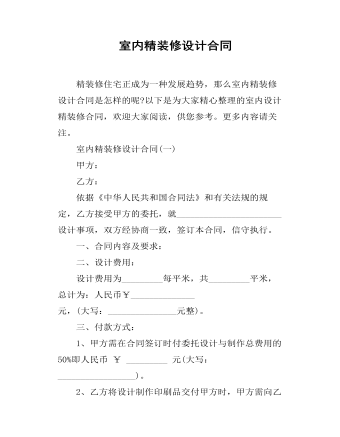
室内精装修设计合同
精装修住宅正成为一种发展趋势,那么室内精装修设计合同是怎样的呢?以下是为大家精心整理的室内设计精装修合同,欢迎大家阅读,供您参考。更多内容请关注。 室内精装修设计合同(一) 甲方: 乙方: 依据《中华人民共和国合同法》和有关法规的规定,乙方接受甲方的委托,就_______________________设计事项,双方经协商一致,签订本合同,信守执行。 一、合同内容及要求: 二、设计费用: 设计费用为_________每平米,共_________平米,总计为:人民币¥______________ 元,(大写:_______________元整)。三、付款方式: 1、甲方需在合同签订时付委托设计与制作总费用的50%即人民币 ¥ _________ 元(大写:_________________)。 2、乙方将设计制作印刷品交付甲方时,甲方需向乙方支付合同余款,即人民币¥______________元(大写:_________________
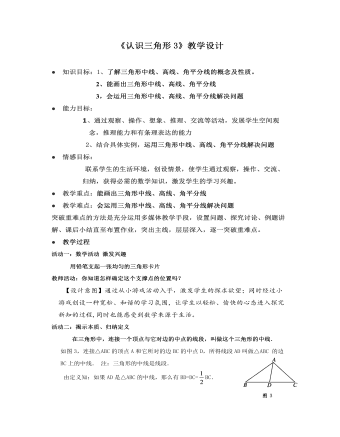
认识三角形教案教学设计
四个同学为一个合作小组;每个小组利用教师为其准备的各类三角形,作出它们的高.比一比,看哪一个小组做得最快,发现的结论多. 师生行为:学生操作、讨论,教师巡视、指导,使学生理解【设计意图】通过让学生操作、观察、推理、交流等活动,来培养学生的动手、动脑能力,发展其空间观察.活动结论:1.锐角三角形的三条高都在三角形内; 2.直角三角形的一条高在三角形内(即斜边上的高),而另两条高恰是它的两条直角边; 3.钝角三角形的一条高在三角形内,而另两条高在三角形外.(这是难点,需多加说明) 总之:任何三角形都有三条高,且三条高所在的直线相交于一点.(我们把这一点叫垂心)课堂小结 1.三角形中三条重要线段:三角形的高、中线和角平分线的概念. 2.学会画三角形的高、中线和角平分线.
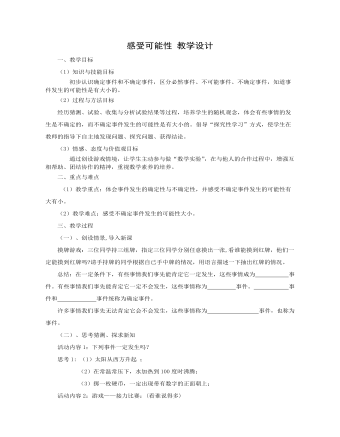
感受可能性教案教学设计
(一)、创设情景,导入新课摸牌游戏:三位同学持三组牌,指定三位同学分别任意摸出一张,看谁能摸到红牌,他们一定能摸到红牌吗?请手持牌的同学根据自已手中牌的情况,用语言描述一下抽出红牌的情况。总结:在一定条件下,有些事情我们事先能肯定它一定发生,这些事情成为 事件。有些事情我们事先能肯定它一定不会发生,这些事情称为 事件。 事件和 事件统称为确定事件。许多事情我们事先无法肯定它会不会发生,这些事情称为 事件,也称为 事件。
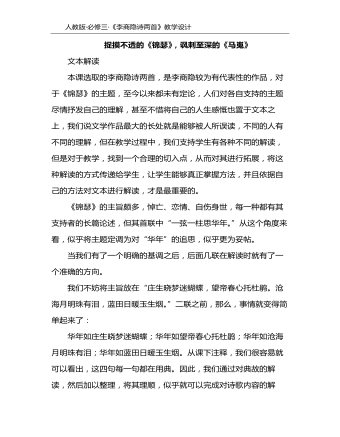
李商隐诗两首教学设计教案
我们不妨将主旨放在“庄生晓梦迷蝴蝶,望帝春心托杜鹃。沧海月明珠有泪,蓝田日暖玉生烟。”二联之前,那么,事情就变得简单起来了:华年如庄生晓梦迷蝴蝶;华年如望帝春心托杜鹃;华年如沧海月明珠有泪;华年如蓝田日暖玉生烟。从课下注释,我们很容易就可以看出,这四句每一句都在用典。因此,我们通过对典故的解读,然后加以整理,将其理顺,似乎就可以完成对诗歌内容的解读;至于什么悼亡、爱情,不妨抛之脑后,毕竟,没有那些其他的主题,也并没有让诗歌失色,而加上这些捉摸不定的主题,只是让诗歌增加了所谓的神秘色彩,徒增阅读难度而已。
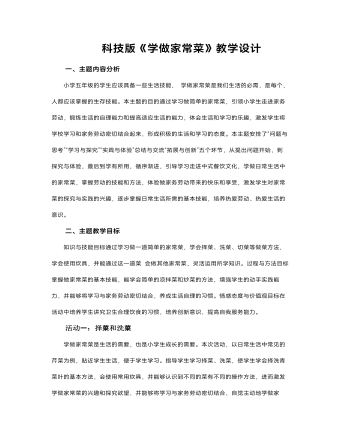
学做家常菜教学设计教案
小学五年级的学生应该具备一些生活技能, 学做家常菜是我们生活的必需,是每个,人都应该掌握的生存技能。本主题的目的通过学习做简单的家常菜,引领小学生走进家务劳动,锻炼生活的自理能力和提高适应生活的能力,体会生活和学习的乐趣,激发学生将学校学习和家务劳动密切结合起来,形成积极的生活和学习的态度。本主题安排了“问题与思考”“学习与探究”“实践与体验”总结与交流“拓展与创新”五个环节,从提出问题开始,到探究与体验,最后到学有所用,循序渐进,引导学习走进中式餐饮文化,学做日常生活中的家常菜,掌握劳动的技能和方法,体验做家务劳动带来的快乐和享受,激发学生对家常菜的探究与实践的兴趣,逐步掌握日常生活所需的基本技能,培养热爱劳动、热爱生活的意识。
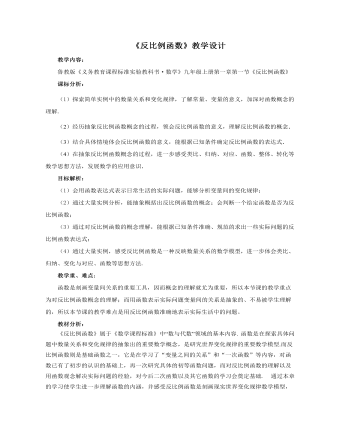
反比例函数教案教学设计
本节的内容主要是反比例函数的概念教学.反比例函数概念的建立,不能从形式上进行简单的抽象与概括,而是对这些实例从不同角度抽象出本质属性后,再进行概括。教材设计的基本思路是从现实生活中大量的反比例关系中抽象出反比例函数概念,让学生进一步感受函数是反映现实世界中变量关系的一种有效数学模型,逐步从对具体反比例函数的感性认识上升到对抽象的反比例函数概念的理性认识. 同时本节的学习内容,直接关系到本章后续内容的学习,也是继续学习其它各类函数的基础,其中蕴涵的类比、归纳、对应和函数的数学思想方法,对学生今后研究问题、解决问题以及终身的发展都是非常有益的.基于以上分析,本节教学设计是建立在一个个数学活动的基础上,经过对情境理解、本质抽象的积累而形成的.让学生对一类问题情境中两个变量间的关系,在充分经历写表达式,计算函数值和观察函数值随自变量变化规律的过程中,逐步概括形成反比例函数的概念.针对教学实际,我选取了贴学生现实的,有价值的实例“文具店里买学习用品”和“剪面积为定值的长方形纸片”等作为问题情境.

